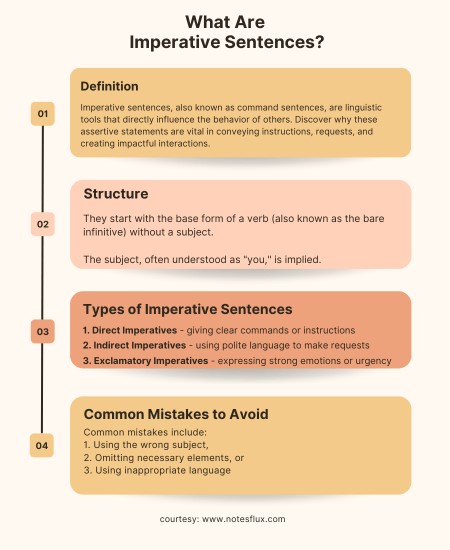
Ever wondered how language wields its influence over us? Get ready to unravel the hidden power of words with imperative sentences – the driving force of communication that commands action.
1.1 Definition
Imperative sentences, also known as command sentences, are linguistic tools that directly influence the behavior of others. Discover why these assertive statements are vital in conveying instructions, requests, and creating impactful interactions.
2. Understanding Imperative Sentences
2.1 The structure and formation of imperative sentences
Imperative sentences possess a straightforward structure, usually starting with the base form of a verb (also known as the bare infinitive) without a subject. The subject, often understood as "you," is implied.
In imperative sentences, the subject is often implied, creating a unique clause structure that focuses on commands, instructions, or requests.
This concise and direct formation makes imperative sentences highly effective in conveying commands or instructions. Whether it's urging someone to take action or issuing a firm request, the simplicity of imperative sentences allows for clear and efficient communication in various contexts.
2.2 Difference between declarative, interrogative, and imperative sentences
Declarative, interrogative, and imperative sentences differ significantly in their purposes and structures.
Declarative sentences state facts or opinions and end with a period, expressing information or making statements.
Interrogative sentences, on the other hand, seek information and conclude with a question mark. They inquire about something or request clarification.
Imperative sentences, as the name suggests, issue commands or directives to instruct or persuade someone to take action. They typically start with a verb in its base form and omit the subject, with the subject "you" implied. These distinctive sentence types cater to various communicative needs, contributing to the richness and versatility of the English language.
2.3 Examples of imperative sentences to illustrate their usage
- Close the door before leaving.
- Please pass me the salt.
- Take a deep breath and relax.
- Don't forget to turn off the lights.
- Stay focused and study for the exam.
- Give me a call later.
- Be kind to others.
- Enjoy your meal!
- Turn right at the next intersection.
- Follow the instructions carefully.
3. Types of Imperative Sentences
3.1 Direct Imperatives (giving clear commands or instructions)
Direct imperatives are straightforward commands or instructions that leave no room for ambiguity. They are assertive and usually begin with a base verb, addressing the subject directly.
These sentences often end with an exclamation mark, emphasizing urgency or importance. For example, "Close the window!" or "Finish your homework now!"
Direct imperatives are commonly used in emergency situations, giving orders, or expressing strong requests, making them a vital part of effective communication.
3.2 Indirect Imperatives (using polite language to make requests)
Indirect imperatives employ polite language to make requests, softening the tone and showing respect for the listener.
They often use phrases like "please" or "could you" to make the request more polite and less assertive. For instance, "Could you please pass me the salt?" or "Would you mind turning down the music, please?"
Indirect imperatives are commonly used in formal situations, social interactions, and customer service scenarios, contributing to effective and courteous communication.
3.3 Exclamatory Imperatives (expressing strong emotions or urgency)
Exclamatory imperatives convey strong emotions or urgency, using an exclamation mark to emphasize the intensity of the command.
They are often used to express excitement, surprise, or urgency. For instance, "Hurry up!" or "Stop right there!"
Exclamatory imperatives grab the listener's attention and add a sense of urgency to the command, making them effective for emergency situations or when immediate action is required.
They are a powerful tool in communication, leaving a lasting impact on the listener.
4. Common Mistakes to Avoid
4.1 Identifying errors in using imperative sentences
Identifying errors in using imperative sentences is crucial for effective communication.
Common mistakes include using the wrong subject, omitting necessary elements, or using inappropriate language.
Top Tip: To ensure clarity, imperative sentences should have a clear subject and verb, and the context should guide the tone.
Avoiding abruptness and choosing polite language when needed is also essential. By understanding these errors, one can improve the impact and accuracy of imperative sentences, enhancing overall communication skills.
4.2 Proper punctuation (and capitalization) in imperative sentences
Proper punctuation and capitalization are essential in imperative sentences for clear and effective communication.
Imperatives end with a period (.), which helps distinguish them from other sentence types. Having said that, exclamation marks (!) can be used to add emphasis or urgency to the command.
Capitalization rules still apply, beginning the sentence with a capital letter.
Ensuring correct punctuation and capitalization helps convey the intended tone and meaning of imperative sentences, making them more impactful and easily understandable.
5. Conclusion
In conclusion, mastering the art of imperative sentences allows us to wield the power of clear and concise language in expressing commands and requests. Whether giving direct instructions, making polite appeals, or conveying urgent emotions, understanding the nuances of imperative sentences enhances our communication skills.
By using the appropriate tone and punctuation, we can effectively convey our intentions and ensure our messages are received with clarity and impact.
Embracing the versatility of imperative sentences empowers us to become more effective communicators in various situations.



